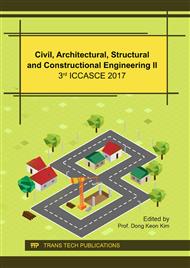p.179
p.183
p.197
p.202
p.213
p.219
p.224
p.229
p.236
Cooperative Innovation Evolutionary Game Analysis of Industrialized Building Supply Chain
Abstract:
Great changes have taken place in construction methods of industrial building relative to traditional construction. The cooperation between construction contractors, prefabricated parts suppliers and other materials and equipment suppliers in the supply chain of the industrial building can not be ignored. The evolutionary game theory can be used to explain the dynamic trend of the relationship until it is stable. The evolutionary game theory is applied to study the process and method of cooperative innovation between construction contractor and many subcontractors. Based on evolutionary game theory, the paper discusses the process and method of cooperative innovation between the construction contractors and numerous subcontractors. It focuses on the analysis of the influence of cooperative profit distribution, spillover effect, innovation subsidies and cooperation risk sharing for evolutionary stable strategy. The evolutionary game model of cooperation parties is constructed. The key indexes such as profit, risk loss, distribution of excess income and innovation cost are considered comprehensively. The results show that with the increasing of the spillover effect, innovation cooperation, suppliers’ innovation income and excess returns of cooperation innovation, the system will tend to the stability of cooperation. And with the increasing of the contractor's subsidy coefficient, the innovation cost, cooperation innovation risk cost, the system will tend to uncooperative. There exists an optimal distribution coefficient of excess income, which can strengthen the cooperation willingness of both sides. This study provides a guidance for the cooperative innovation of the supply chain participating parties.
Info:
Periodical:
Pages:
213-218
Citation:
Online since:
February 2018
Authors:
Price:
Сopyright:
© 2018 Trans Tech Publications Ltd. All Rights Reserved
Share:
Citation:


